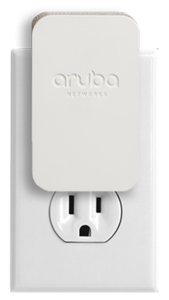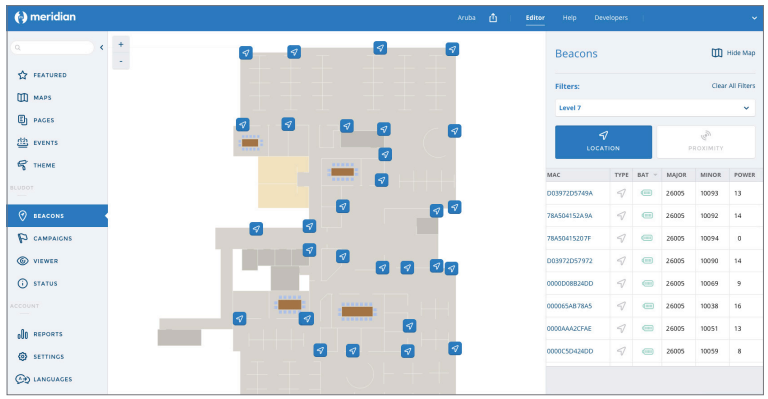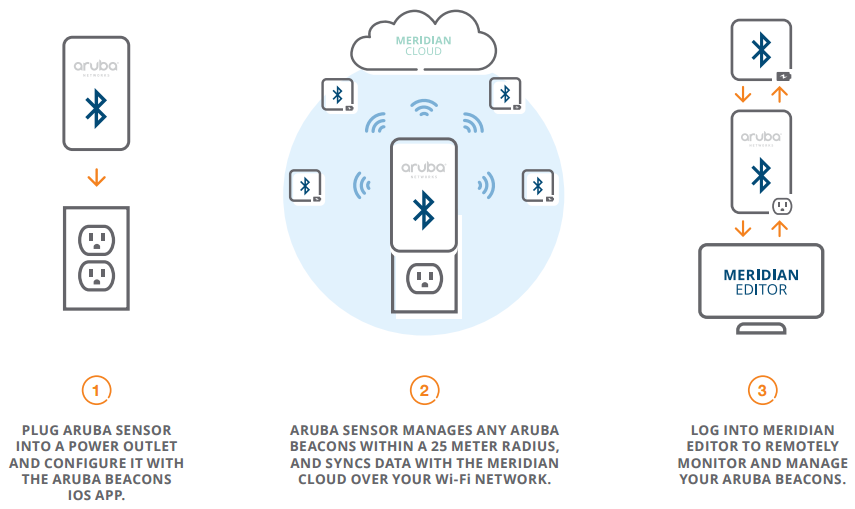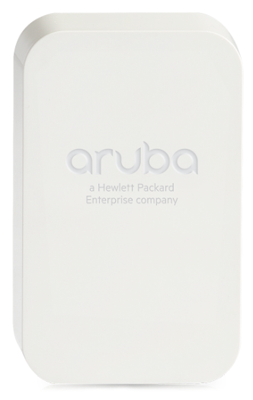 Overview:
Overview:
Aruba Mobile Engagement enables venues to engage with visitors' mobile devices using Aruba Beacons powered by Bluetooth Low Energy (BLE) and the Meridian mobile-app platform. With Aruba Sensor (AS-100), Aruba, a Hewlett Packard Enterprise company, is now opening up its solution to additional Wi-Fi networks to create a complete offering for all public-venue customers.
The Aruba Sensor is a small, dual-band 802.11n client radio and a BLE radio that can act as an additional Aruba Beacon to power mobile engagement applications without battery power. Aruba Sensor also allows all enterprises - whether they are Aruba Wi-Fi customers or not - to remotely manage their Aruba Beacon deployments over their existing Wi-Fi infrastructure.
- Dual band 802.11n 1x1 client radio (network connectivity)
- Bluetooth Low-Energy (BLE) radio (indoor positioning, provisioning)
- Advanced Cellular Coexistence (ACC)
- Direct AC power plug-in, and option to power over USB
- Lock and optional tamper-proof casing

Remote management tools
Easily manage Aruba Beacon data such as battery life, power settings, and security without having to go onsite.

Easily scale deployments
Turn your proof-of-concept into a multi-location deployment by pulling beacon data into one centralized location.

Works on any Wi-Fi
No need to alter your existing Wi-Fi infrastructure; Aruba Sensor connects as a client to your existing Wi-Fi network.
Benefits:
Aruba Sensor
The Aruba Sensor plugs directly into an AC outlet and can hear other Aruba Beacons within a 25-meter range and reports relevant data over Wi-Fi to a cloud-based management system (called the Meridian Editor).
Aruba AS-100 enables the capability to centrally manage Aruba Beacons available to any venue, regardless of their wireless network vendor, so that they can manage an Aruba Beacon-based Mobile Engagement solution quickly and easily from a convenient location.
The multivendor Aruba Sensor allows larger venues with an extensive Aruba Beacon deployment to easily manage all of these devices without having to go on-location to individually check each beacon or alter their existing wireless infrastructure.
Configuring the Aruba Sensor
Venues use the same tool to configure their Aruba Beacons and Aruba Sensors - a mobile app called the Aruba Beacons App. The Aruba Beacons App can be downloaded for free to an iOS device. There, venues simply log in using their existing Meridian Editor account credentials.
The Aruba Beacons App associates the Aruba Sensor with the appropriate Meridian account's venue maps so that you can place the Sensor on a digital map that corresponds with its physical location. The app also provides an interface to connect the Aruba Sensor device to the venue's existing Wi-Fi network.
After the initial one-time configuration, the Aruba Sensor will then automatically send Aruba Beacon data at regular intervals over the Wi-Fi to the Meridian Editor where venues can remotely access it.
Enterprise-Grade Beacon Management
Large Aruba Beacon deployments require centralized management tools that reduce operating expenses and allow public-facing venues - regardless of their existing wireless infrastructure - to engage in a BLE beacon-based mobile engagement strategy.
The Multivendor Aruba Sensor works together with the Meridian mobile app plaform, Aruba Beacons app, and Aruba Beacon hardware to provide venues with a complete, enterprise-grade Mobile Engagement solution that is easy and intuitive to deploy and maintain.

Beacons management dashboard
How It Works:
After initially configuring Aruba Sensor and plugging it into a venue's AC outlet, Aruba Sensor automatically sends the data of all Aruba Beacons within range to the Meridian cloud server over the venue's existing Wi-Fi connection.
Aruba Sensor automatically sends updated data on a beacon's battery life, status, settings such as power level, and campaigns to one centralized location - the cloud-hosted Meridian Editor. This means that venues can simply log in to the same cloud-based content management system to both manage their app content and change the nature of their physical beacon hardware.

Wireless Radio Specifications:
| |
Maximum transmit power (dBm) per transmit chain |
Receiver sensitivity (dBm) per receive chain |
| 1 Mbps |
10.0 |
-86.0 |
| 11 Mbps |
10.0 |
-84.0 |
| 6 Mbps |
10.0 |
-86.0 |
| 54 Mbps |
10.0 |
-71.0 |
| MCS0/8 |
10.0 |
-86.0 |
| MCS7/15 |
10.0 |
-67.0 |
| MCS0/8 |
10.0 |
-83.0 |
| MCS7/15 |
10.0 |
-64.0 |
| 6 Mbps |
10.0 |
-86.0 |
| 54 Mbps |
9.0 |
-71.0 |
| MCS0/8 |
10.0 |
-86.0 |
| MCS7/15 |
9.0 |
-67.0 |
| MCS0/8 |
10.0 |
-83.0 |
| MCS7/15 |
9.0 |
-64.0 |
Maximum capability of the hardware provided (excluding antenna gain). Maximum transmit power is limited by local regulatory settings.


 Overview:
Overview:![]()
![]()
![]()


